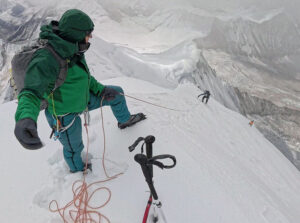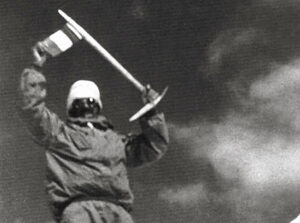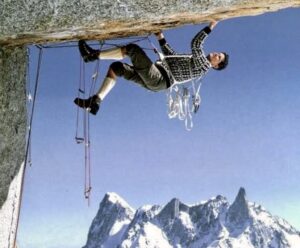Barely 12 hours after the dramatic rescue of three Russian climbers, Annapurna Base Camp is deserted.
“We’re all back in Pokhara,” Uta Ibrahimi told ExplorersWeb. Elated after bagging her 6th 8,000’er, the climber from Albania-Kosovo has been celebrating with an extraordinarily large group of fellow summiters. She will “most probably” head next to Dhaulagiri, like many of the Seven Summit Treks group.

Pasang Lamu and two other female Sherpas on the summit of Annapurna. Photo: Pasang Lamu
Their social media postings show happy faces on the summit, news of many first national ascents, and an unprecedented number of 14 women summiters (six Nepalese and eight foreigners). Even on oxygen, they have all surely have gone through very tough moments after three days in Camp 4, a failed summit attempt due to lack of ropes, and unstable weather the day before the final push.
There are also all-too-familiar images of an endless line of climbers marching up the white upper slopes of the mountain. The amount of O2 consumed, if calculated, will surely result in another record. The images bring back the saddest memories of recent Everest. And as on Everest, some voices demand a limit to climbing permits.

Shades of Everest: Crowds on the upper slopes of Annapurna. Photo: Pasang Lamu
However, the crowding is not just about the number of permits, but the fact that everyone headed up the same day, at the same time: paying climbers marching right behind the team of Sherpa guides fixing the ropes on the go. The 2021 Annapurna season has lasted two weeks, and all the summits occurred within a couple of hours.
Moreover, such summit success seemed doubtful a day earlier, when the rope-fixing team stopped the first summit push at 7,400m.
“We’d taken 6,500m of rope, which we felt would be enough,” Mingma Dorchi Sherpa, director of Pioneer Adventure and a member in the rope-fixing team, told ExWeb correspondent Shashwat Pant. “On early April 15, we started summit push, but realized we didn’t have enough ropes — we needed approximately 800m more. Weather also started to get bad with snow falling, so we decided to return to Camp 4 and stay there for the night.”

Mingma Dorchi Sherpa. Photo: Pioneer Adventure
From Dorchi’s account, the situation could have turned for the worse very easily. First, there was not enough space in Camp 4 for all the tents. “Camp 4 had not enough space for all, so we set up camps where we felt we would be safe, some low and some high,” he said.
Second, the unexpected days at altitude led to a shortage of oxygen. But then the helicopter also dropped some extra canisters, in addition to the 800m of rope. “In fact, these 800m were also not enough, but the climbers were willing to take the risk. In the end, the upper sections were safe without ropes.”
Pant asked Mingma Dorchi how was it that they ran out of ropes.
“Sometimes this happens,” said Dorchi. “We needed ropes on a few extra sections because we wanted to ensure safety, and used fixed ropes where we thought some might feel unsafe.” He added that there were some crevasses that climbers just used to jump. “But with such large numbers, we had to [use ropes]. We didn’t want to take a chance.”

Overcoming a steep section with fixed ropes. Photo: Uta Ibranihi
Dorchi continued:
“Also, sections between Camps 1 and 2 needed extra rope for safety. Blue ice in the last section also forced us to wait for the ropes’ resupply. Going without would have been disastrous.”
“If there had been fewer people, we would have been able to go for the summit on April 15, but with so many, we needed to ensure we had enough fixed ropes.”
For the local operators and staff, it’s been a total success. “We had a tough time, but everyone came back safe,” Dorchi said. “Even the lost Russian climbers were rescued.”
Dorchi said that they were not aware of the Russians’ disappearance.
“We started our descent on April 17, reached BC that evening, and headed [home] the following day, so we understood that everybody was on their way down at their own pace. Maya Sherpa came to BC one day later, so we just hoped they would eventually make it down, but losing radio contact was a red flag.”

Alexander Lutokhin of Russia and Israfil Ashurly of Azerbaijan in Kathmandu. Photo: RussianClimb
The Russian climbers are back in Kathmandu today. Sergey Kondrashkin and Dmitry Sinev are in the hospital while Alexander Luthokin, who didn’t summit, needed no medical treatment.
Remarkably, they were among the very few (between four and seven climbers, according to preliminary data) who summited without supplementary oxygen.
Of these, three of them didn’t make it back to Base Camp under their own power. Besides the Russians, Lu Chung Han of Taiwan asked for a helicopter rescue from Camp 3 because he was afraid that he would be too slow crossing the dangerous section from there to C2 because of mild frostbite. Lu is now in Kathmandu. However, he intends to climb Dhaulagiri in a few days.
For Dorchi, the large number of climbers on the mountain is a positive. “It’s good for Nepal’s mountaineering,” he said.
For many in the mountaineering community, however, not all means justify the end. Little by little, commercial climbs on the 8,000’ers seem to be drifting ever further away from the classical values of progressively gained experience, self-sufficiency, and technical skill.






